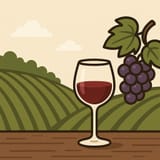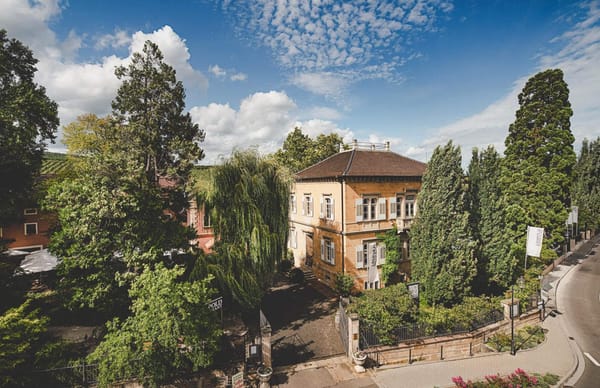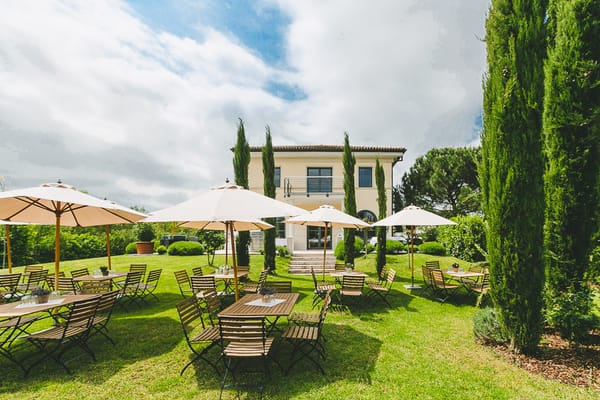What Is Wine? 🍇
More than just fermented grape juice - wine is nature, craft, history, and mystery. Let’s uncork the basics together.

A simple question with centuries of stories behind it.
Before we start swirling glasses and decoding tasting notes, I want to ask a fundamental question:
What actually is wine?
It seems obvious, right? You drink it. It tastes good. It’s on the dinner table at celebrations. Maybe it’s something you’re just now getting into - or something that’s always been around, like it was for me growing up in the Pfalz.
But wine is more than just a drink. It’s part nature, part human craft, part history, and part mystery.
So let’s uncork this question properly.
🍷 The Literal Definition: Fermented Grape Juice
At its most basic, wine is fermented grape juice. Nothing more, nothing less.
You take grapes (mostly Vitis vinifera, a species cultivated for winemaking), crush them to release their juices, and let yeast, either wild or added, convert the natural sugars into alcohol through fermentation.
That’s the textbook answer. But if that’s all wine was, this blog probably wouldn’t exist.
“Wine is sunlight, held together by water.”
— Galileo Galilei
🌱 It Starts with the Grape
Not all grapes are equal.
Wine grapes are smaller, sweeter, and have thicker skins than the ones you snack on. Their high sugar content is perfect for fermentation. But the magic lies in what happens before fermentation even begins - because everything from:
- Climate and weather
- Soil composition (terroir)
- Sunlight exposure
- Harvest timing
- Altitude and slope
…affects the final result in your glass.
For example, Riesling grown in the Pfalz tastes different from Riesling grown in Australia, even if the grapes share the same name. Why? Because the land leaves a fingerprint.
This is why wine is sometimes called a bottled expression of a place. Pretty poetic, right?
🧪 Then Comes Fermentation (AKA: Controlled Magic)
This is where yeast comes into play.
During fermentation, yeast cells “eat” the sugar in the grape juice and produce alcohol, carbon dioxide, and heat. But depending on how long fermentation is allowed, how much oxygen is present, and what vessel it’s done in (stainless steel? oak barrel? clay amphora?) - you get very different wines.
Some are light and crisp. Others are bold, earthy, and complex.
It’s chemistry, yes. But also… alchemy.
🧔♂️ The Human Touch
Wine doesn’t just happen. People make choices at every step:
- When to harvest (too early = sour, too late = too sweet)
- How to press (gentle for whites, more aggressive for reds)
- How long to age, and in what vessel (stainless steel? oak? old barrels?)
These decisions shape the final wine. That’s why even neighboring winemakers in the same region can produce dramatically different bottles.
It’s a craft. And sometimes an art.
🏛️ A Liquid with a Long History
Wine isn’t new. It’s ancient.
The oldest known winemaking evidence dates back over 8,000 years to Georgia (the country, not the U.S. state). The Egyptians, Greeks, and Romans all had their own wine gods and rituals.
It’s been used in religion, medicine, celebration, and trade. Across Europe, monks in monasteries kept the tradition alive during the Middle Ages. In many ways, wine is deeply entwined with the development of human civilization.
So every time we open a bottle, we’re sipping something with a lineage as old as writing, cities, and storytelling.
🧠 Why It’s More Than Just a Drink
Wine is rich in context. That’s what makes it different from other drinks.
- It reflects the place it came from.
- It reflects the person who made it.
- It changes with time, just like us.
- It brings people together around a table.
- And sometimes, it opens up conversation in ways nothing else can.
You don’t need to know all this to enjoy a glass. But once you start learning, wine becomes so much more than what’s in the bottle.
It becomes a way to explore the world.
🎨 Wine Is Personal
This blog isn’t just about learning wine “the right way.”
It’s about my journey—and hopefully, a bit of yours too.
For me, wine is:
- That earthy smell walking through a Pfälzer vineyard in September
- The clink of glasses on a warm summer night
- The mystery of reading a label and wondering, what’s this going to taste like?
- The quiet ritual of pouring a glass after a long day
So yes - wine is fermented grape juice.
But it’s also life, bottled.
“Wine makes daily living easier, less hurried, with fewer tensions and more tolerance.”
— Benjamin Franklin
🧭 What’s Coming Next
In the next few posts, I’ll be exploring:
- The different types of wine (and no, it’s not just red vs. white)
- What makes a wine “dry” or “sweet”
- How to taste wine without feeling awkward
- And maybe even some fun wine experiments and stories from the road
Whether you’re new to wine or already a fellow enthusiast, I’m happy you’re here.
🎶 A Sip with a Soundtrack
If you’re reading this with a glass of red in hand (and I hope you are), here’s a song that fits the mood perfectly:
🎵 Il n'y a pas d'amour heureux (Remasterisé en 2016) by Françoise Hardy
Play it. Sip slowly. Let the wine - and the music - do what they do best.
Until next time,
Tobi 🍷




